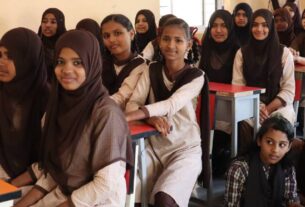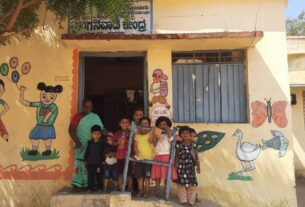With taps running dry, Sindhanur residents face daily struggles for clean water. As the crisis deepens, calls for urgent action echo through the parched streets.
In the arid heartland, the once richest district of Karnataka, Sindhanur, where the earth cracks like parched lips and the sun beats down relentlessly, lies a landscape stripped bare by the cruel absence of water. Here, where the once mighty rivers have dwindled to mere trickles and the soil lies cracked and barren, life hangs in delicate balance, teetering on the edge of despair.
In the absence of water, life struggles to survive in this harsh and unforgiving landscape. The once verdant fields lie fallow, their cracked and barren soil offering little solace to the weary farmers who toil endlessly in search of sustenance. Cattle roam listlessly in search of grazing land, their emaciated forms a haunting reminder of the toll exacted by drought.
Sunil Mistry, a former member of the panchayat said, “The rivers waters that once flowed freely through this land now lie stagnant and still, their once mighty waters reduced to stagnant pools choked with algae and debris.” He also said, “Yet amidst the desolation, there is a quiet resilience that refuses to be extinguished. Communities come together in solidarity, sharing what little resources they have in a desperate bid to survive. Children play amidst the dust and heat, their laughter a beacon of hope in time of struggle.”

Marie Kumarappa, a single mother of two who works day in and day out to make basic ends meet talked about often the children fall sick having acute diarrhoea and sometimes food poisoning. She had said that there seems to be no way of avoiding the consumption of unclean water as it is likely the only source for a long time now. She had added, “If only we had gotten proper water supply or could at least afford to get cans every now and then, this problem wouldn’t have been there.”
Despite the hardships she faces, Marie’s optimism never wavers. She sees potential where others see obstacles, her determination serving as a guiding light through the darkest of times. She goes on to talk about how it cost her an arm and a leg to receive treatment for her kids. “The doctors were quick to dismiss my kids by saying it was just a stomach problem until I came back in fifteen days with the same problem to them, “she said. Marie also said that if it weren’t for her desperation to find out what really was the cause of it, unclean water consumption wouldn’t have been pointed out until now.
How did this start?
The building of the Tungabhadra Dam is among the most important events in the irrigation history of the area. The dam, which was completed around the 20th century, is essential for controlling the Tungabhadra River’s flow and supplying water for cultivation. In addition, the dam’s reservoir is a significant source of hydroelectric power and potable water.

The canal distribution network in Sindhanur branches out from the Tungabhadra Canal, which originates from the Tungabhadra Dam. These canals distribute water to various agricultural lands in and around Sindhanur, facilitating cultivation and contributing to the region’s agricultural economy.
Modern challenges and developments in recent times include issues such as water scarcity, inefficient water management practices, and disputes over water distribution have emerged in the region.
Sindhanur has only two water tanks for the entire district. The 31 wards, 113 villages and the Rehabilitation camps have one main source of drinking water and for other purposes like cooking, cleaning, washing clothes and taking baths which is the Tungabhadra canal. There are no processors or purifiers and taps to clean the water that is consumed by the people there. Water tanks provide water supply only once in two weeks to the wards and villages. The district’s wards and rehabilitation centers are in the worst possible condition. It’s not very often that the supply which is supposed to reach every location. There are water pipes that are empty and tanks that are devoid of water.
The problem is that they are not getting enough water to utilize and are not consuming clean water. The agricultural lands where they practice farming get their water from the canal, which is still unfit for crop cultivation. They are not being made aware of the water cycle, including usage and consumption say the officials from the municipal corporation unit.
Ayyappa, a town local and an employee at the municipal corporation unit of Sindhanur emphasises on the fact that water crisis had not been an issue as much as there is today. The water tanks had been sent out once in three or four days initially, as the groundwater depletion began and as soon as the open canal had been used up for daily uses, it became an issue. The open canal is source to all households and mainly 80 percent of it goes to agricultural lands.
He mentioned, “The issue revolves around processing the water that is consumed, we boil it and think all dirt and dust has vanished.” He added, “It is still fine for people for who are earning a stable amount but for the villagers and the people in the slum, it becomes more difficult for them to understand the dangers of consuming water just directly from the canal.”
A walk too long
Guru, a college dropout, said, “I stopped studying as I had to start earning to make ends meet.” We in the neighborhood can only imagine the difficulties the rehabilitation camps have in obtaining sufficient supply of clean water. He continued by saying that his father was unable to continue farming since pesticides had further harmed crops, contaminated borewell water had been used in the fields, and the market vendors under my father’s contract had received little to no produce.
Regarding the water supply in their Burma camp, one of the rehabilitation camps in Sindhanur, Selvam and Shanmugam, two residents of the camps situated 15 kilometers from the town, held similar views. They claimed to have boiled the water they drank twice or three times, coming from the open canal. Cans of Bisleri, Bisley, Bisli etc., are purchased by those who can afford water cans, and they are used for three or four days.
According to the rural Police Sub Inspector (PSI), the municipality is facing several issues, one of which is related to the water supply. He warned that there would be a severe draught in the town and that it would be challenging to mediate disagreements between ward members and the residents on this issue. The policeman said that since minor altercations frequently result in residents losing an arm and a leg having a sufficient water supply should take care of the problem.
Villagers tend to rush to the Taluk government hospital or a clinic 10 to 12 kilometers away in case of food poisoning or diarrhoea, sometimes even cholera. They usually do not understand the cause of it until they visit the local health care center. Dr. Ayanna Gowda, a senior doctor in the Taluk General hospital of Sindhanur comments on the issue by saying that acute diarrhoea and food poisoning are only minor emergency cases that are not registered as water borne diseases. However, medical aid such as antibiotics and fluids are given as a form of temporarily fixing the concern. Other doctors say that serious water borne diseases like Cholera are not registered as it is generally treated with normal antibiotics that treat general weakness rather than it as a disease.
It’s all relative
The reasons that this problem exists is due to the economic status that a lot of them hold which is below par, the town has no access to information and better understanding of how to use resources. The villagers and the people in the slum seem to be completely unaware that canal water cannot be used for all purposes and that children are consuming the same unclean water through crops also having heavy usage of pesticides too adding to the already existing issue of clean water processors and taps being absent.
The camp residents have utilized the canal water for bathing, washing clothes, and occasionally even blending alcohol. Consequently, it leads to the contamination of the canal water. Eventually, using the same water for cooking and drinking would only result in severe diarrhoea and cholera.
Officials from the municipal corporation unit say that the problem has worsened over the past 10 years due to the fast depletion of the main water source, it being the water from the river Tungabhadra. According to reports, Sindhanur is considered one of the most backward Taluks in terms of water resources. Research papers show that severe health conditions are listed to happen due to consumption of untreated water and water from common sources.
The panchayat claims that the Jal Jeevan scheme helps the wards and camps, but there are taps that have no connection line just built at random places. The scheme shows the number of taps set up but has not ensured that the pipe line connections actually let out water to the houses.
Agricultural lands are filled with toxins and pesticides, the borewell water that is supposedly used to help with the growth of the crop is adversely destroying it, according to various other reports and statements by farmers, the water that is filled with high levels of salt, which is dangerous to consume on a regular basis. Water purification methods that are used in several areas are nothing but boiling of water.
Dr. Ayanna says that it is of no help to think water can be pure to drink with just boiling it one or two times, the lack of awareness is a problem to many. He also states the recurring diarrhoea issues can lead to further complications like blood loss, piles as water retention would be below minimal levels after continuous loss of nutrients and water levels in the body, severe weakness and others. He also suggests that programs from the hospital and NGO’s must be conducted for issues like these.
Sujit Kumar Dhali, the owner of an NGO called Shanthidarshan said, “The issue of water resources depleting has been taking place for a long time now, this has to be a wakeup call. We are in a drought situation, and it can get only worse from here, the need for water is going to increase, where will the people go except for the canals which are rapidly drying up and have debris collection on it. Authorities need to help with this situation before it gets out of hand.”




